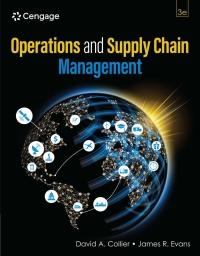Im an accounting major, not an operations expert, yelled just-promoted Bob Barthrow, the executive vice president of
Question:
“I’m an accounting major, not an operations expert,” yelled just-promoted Bob Barthrow, the executive vice president of the Midwest Frequent Flyer Call Center, during a senior-level management meeting. “Bob, Horizon Airlines (HA) is going to stop doing business with us if we don’t provide better call center service. We need to maximize service and minimize costs! So, find a solution to HA’s service problems or we are all out of a job,” stated Adam Bishop, the CEO of Midwest Call Center Services (MCCS). Bob retreated to his office and closed the door. As he sat in his chair, he thought about the many meetings he had participated in where managers promised great customer service but could not deliver it. Upon further reflection, he came to the conclusion that to promise great customer service you first must know how to analyze resource capacity and develop good schedules. He pulled out his old college operations management textbook and began reading. He also did a Google search on the topic and found several articles to read. He planned on building an electronic spreadsheet analysis of the situation. Small and mid-sized airlines outsourced a variety of peripheral services to MCCS, such as billing and credit card management, baggage and customer flight claims management, reservations, loyalty programs, and call center management. HA accounted for nine percent of MCCS revenues. HA customers had no idea that the HA frequent flyer program was outsourced to MCCS. MCCS managed separate call centers for several airlines, each with its own dedicated staff and office space. MCCS customer service representatives (CSRs) who worked in the HA call center were trained by both MCCS and individual airlines such as HA. MCCS provided all CSRs with service management training and mentors, and CSR performance was electronically monitored. HA trained the CSRs by including airline tours and free flights so the CSRs would know the airline and its culture, and especially its frequent flyer program. HA CSRs were trained to handle 20 service upsets most likely to be described by incoming customer calls. HA and GCCS categorized incoming calls into four categories as follows:
1.Redeem calls: The customer wants to redeem frequent flyer points for future airline flights.
2.Problem resolution: The customer wants to correct point debits and credits, flights, personal information, and so on.
3.Manage accounts: The customer wants to split, combine, transfer, delete, rename, and/or update the frequent flyer account(s).
4.Travel advice: The customer asks for travel advice.
MCCS and HA provide “limited travel consulting service and advice.” MCCS CSRs are trained to be nice yet tell the customer they do not provide full travel service, and refer customers to other travel agencies. Average standard times for HA’s call mix is shown in Exhibit15.15. Bob wanted to get a standard service rate in the same units of measure used for other airlines, and that was calls per CSR per 30 minutes. Average HAMCCS call center demand rounded to the nearest integer for the last 10 Mondays is shown in the data file Midwest Frequent Flyer Call Center Data.xlsx. Bob thought a planned (target) CSR labor utilization of 90 percent provided adequate safety capacity. The current HA-MCCS CSR staff schedule can be found in the data file Midwest Frequent Flyer Call Center Staff Schedule. xlsx. Full-time employee (FTE) policies require at least a seven-hour workday plus one hour for lunch or dinner and at least one 15-minute break per workday. Any workday less than FTE is considered part-time employment (PTE). He planned to use a four-step analysis approach, with Step 1 being demand analysis using the data in Midwest Frequent Flyer Call Center Data.xlsx. Step 2 was to compute and explain the logic of setting a standard service time in calls/CSR/30 minutes. Step 3 involved analyzing resource (i.e., staff) capacity using the following equation:

This equation was introduced in Chapter 11.) Step 4 required a revised detailed staff schedule to meet demand to be developed given the target number of CSRs per time period for a given service rate, and an assumption for the target labor utilization. He planned to explain and justify all of his logic and assumptions in a written report to be presented to other managers and his direct reports. Bob also found a year-old study on the cost of poor service for another airline serviced by MCCS, which found the cost of an abandon (customer hangs up for undetermined reason) or busy signal call to be estimated at \($21.\) This was his best estimate of the cost per call for poor customer service. Bob knows his accounting principles, but if he is to be promoted, he must also demonstrate to management that he can analyze a process and successfully manage it. Use the following case questions to help Bob prepare a report.
Case Questions for Discussion:
1.Analyze the case data and current schedule, and answer the following “baseline” questions.
What’s labor utilization for each 30-minute period given the current staffing plan? Is the main problem lack of staff capacity or poor scheduling, or both? Can you support your answer with numerical analysis?
2.What is the cost of abandoned and busy signal calls for a typical Monday? Annually? (Make and state assumptions as needed.)
3.Develop a better CSR staff schedule if needed, and decide whether the company should hire more CSRs or lay off a few. Will you use part-time employees? If so, explain why and justify your reasoning.
4.What are your final recommendations?
Step by Step Answer:

Operations And Supply Chain Management
ISBN: 9780357901649
3rd Edition
Authors: David A. Collier; James Evans





